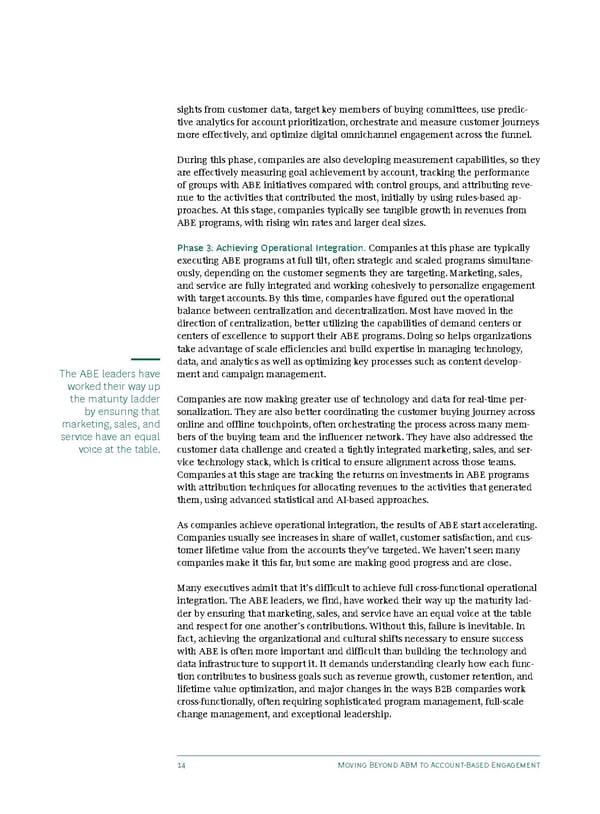sights from customer data, target key members of buying committees, use predic- tive analytics for account prioritization, orchestrate and measure customer journeys more effectively, and optimize digital omnichannel engagement across the funnel. During this phase, companies are also developing measurement capabilities, so they are effectively measuring goal achievement by account, tracking the performance of groups with ABE initiatives compared with control groups, and attributing reve- nue to the activities that contributed the most, initially by using rules-based ap- proaches. At this stage, companies typically see tangible growth in revenues from ABE programs, with rising win rates and larger deal sizes. Phase 3: Achieving Operational Integration. Companies at this phase are typically executing ABE programs at full tilt, often strategic and scaled programs simultane- ously, depending on the customer segments they are targeting. Marketing, sales, and service are fully integrated and working cohesively to personalize engagement with target accounts. By this time, companies have figured out the operational balance between centralization and decentralization. Most have moved in the direction of centralization, better utilizing the capabilities of demand centers or centers of excellence to support their ABE programs. Doing so helps organizations take advantage of scale efficiencies and build expertise in managing technology, data, and analytics as well as optimizing key processes such as content develop- The ABE leaders have ment and campaign management. worked their way up the maturity ladder Companies are now making greater use of technology and data for real-time per- by ensuring that sonalization. They are also better coordinating the customer buying journey across marketing, sales, and online and offline touchpoints, often orchestrating the process across many mem- service have an equal bers of the buying team and the influencer network. They have also addressed the voice at the table. customer data challenge and created a tightly integrated marketing, sales, and ser- vice technology stack, which is critical to ensure alignment across those teams. Companies at this stage are tracking the returns on investments in ABE programs with attribution techniques for allocating revenues to the activities that generated them, using advanced statistical and AI-based approaches. As companies achieve operational integration, the results of ABE start accelerating. Companies usually see increases in share of wallet, customer satisfaction, and cus- tomer lifetime value from the accounts they’ve targeted. We haven’t seen many companies make it this far, but some are making good progress and are close. Many executives admit that it’s difficult to achieve full cross-functional operational integration. The ABE leaders, we find, have worked their way up the maturity lad- der by ensuring that marketing, sales, and service have an equal voice at the table and respect for one another’s contributions. Without this, failure is inevitable. In fact, achieving the organizational and cultural shifts necessary to ensure success with ABE is often more important and difficult than building the technology and data infrastructure to support it. It demands understanding clearly how each func- tion contributes to business goals such as revenue growth, customer retention, and lifetime value optimization, and major changes in the ways B2B companies work cross-functionally, often requiring sophisticated program management, full-scale change management, and exceptional leadership. 14 Moving Beyond ABM to Account-Based Engagement
 BCG moving beyond ABM to account based engagement Page 15 Page 17
BCG moving beyond ABM to account based engagement Page 15 Page 17